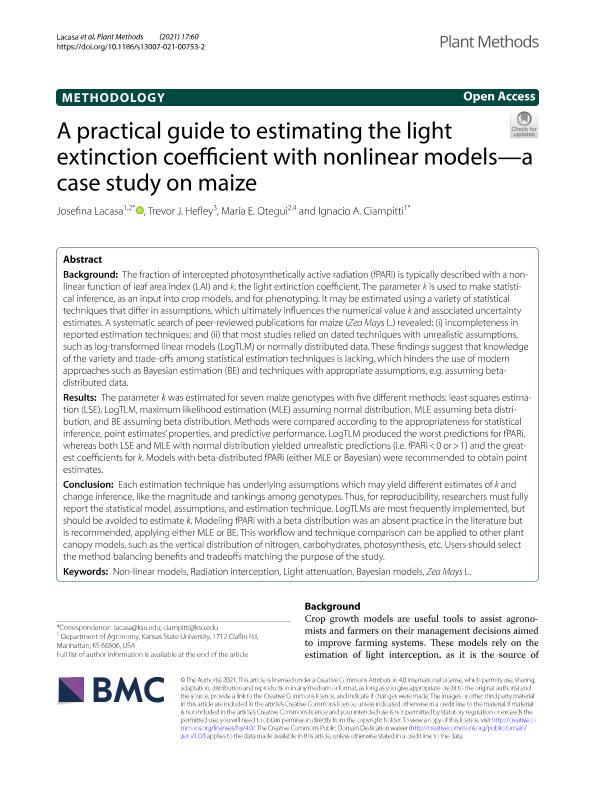Mostrar el registro sencillo del ítem
dc.contributor.author
Lacasa, Josefina
dc.contributor.author
Hefley, Trevor J.
dc.contributor.author
Otegui, Maria Elena

dc.contributor.author
Ciampitti, Ignacio Antonio

dc.date.available
2022-07-20T10:30:07Z
dc.date.issued
2021-12
dc.identifier.citation
Lacasa, Josefina; Hefley, Trevor J.; Otegui, Maria Elena; Ciampitti, Ignacio Antonio; A practical guide to estimating the light extinction coefficient with nonlinear models—a case study on maize; BioMed Central; Plant Methods; 17; 1; 12-2021; 1-11
dc.identifier.issn
1746-4811
dc.identifier.uri
http://hdl.handle.net/11336/162599
dc.description.abstract
Background: The fraction of intercepted photosynthetically active radiation (fPARi) is typically described with a non-linear function of leaf area index (LAI) and k, the light extinction coefficient. The parameter k is used to make statistical inference, as an input into crop models, and for phenotyping. It may be estimated using a variety of statistical techniques that differ in assumptions, which ultimately influences the numerical value k and associated uncertainty estimates. A systematic search of peer-reviewed publications for maize (Zea Mays L.) revealed: (i) incompleteness in reported estimation techniques; and (ii) that most studies relied on dated techniques with unrealistic assumptions, such as log-transformed linear models (LogTLM) or normally distributed data. These findings suggest that knowledge of the variety and trade-offs among statistical estimation techniques is lacking, which hinders the use of modern approaches such as Bayesian estimation (BE) and techniques with appropriate assumptions, e.g. assuming beta-distributed data. Results: The parameter k was estimated for seven maize genotypes with five different methods: least squares estimation (LSE), LogTLM, maximum likelihood estimation (MLE) assuming normal distribution, MLE assuming beta distribution, and BE assuming beta distribution. Methods were compared according to the appropriateness for statistical inference, point estimates’ properties, and predictive performance. LogTLM produced the worst predictions for fPARi, whereas both LSE and MLE with normal distribution yielded unrealistic predictions (i.e. fPARi < 0 or > 1) and the greatest coefficients for k. Models with beta-distributed fPARi (either MLE or Bayesian) were recommended to obtain point estimates. Conclusion: Each estimation technique has underlying assumptions which may yield different estimates of k and change inference, like the magnitude and rankings among genotypes. Thus, for reproducibility, researchers must fully report the statistical model, assumptions, and estimation technique. LogTLMs are most frequently implemented, but should be avoided to estimate k. Modeling fPARi with a beta distribution was an absent practice in the literature but is recommended, applying either MLE or BE. This workflow and technique comparison can be applied to other plant canopy models, such as the vertical distribution of nitrogen, carbohydrates, photosynthesis, etc. Users should select the method balancing benefits and tradeoffs matching the purpose of the study.
dc.format
application/pdf
dc.language.iso
eng
dc.publisher
BioMed Central

dc.rights
info:eu-repo/semantics/openAccess
dc.rights.uri
https://creativecommons.org/licenses/by/2.5/ar/
dc.subject
BAYESIAN MODELS
dc.subject
LIGHT ATTENUATION
dc.subject
NON-LINEAR MODELS
dc.subject
RADIATION INTERCEPTION
dc.subject
ZEA MAYS L
dc.subject.classification
Agricultura

dc.subject.classification
Agricultura, Silvicultura y Pesca

dc.subject.classification
CIENCIAS AGRÍCOLAS

dc.title
A practical guide to estimating the light extinction coefficient with nonlinear models—a case study on maize
dc.type
info:eu-repo/semantics/article
dc.type
info:ar-repo/semantics/artículo
dc.type
info:eu-repo/semantics/publishedVersion
dc.date.updated
2022-07-15T14:46:47Z
dc.journal.volume
17
dc.journal.number
1
dc.journal.pagination
1-11
dc.journal.pais
Reino Unido

dc.journal.ciudad
Londres
dc.description.fil
Fil: Lacasa, Josefina. Kansas State University; Estados Unidos. Universidad de Buenos Aires. Facultad de Agronomía; Argentina
dc.description.fil
Fil: Hefley, Trevor J.. Kansas State University; Estados Unidos
dc.description.fil
Fil: Otegui, Maria Elena. Universidad de Buenos Aires. Facultad de Agronomía; Argentina. Instituto Nacional de Tecnología Agropecuaria. Centro Regional Buenos Aires Norte. Estación Experimental Agropecuaria Pergamino; Argentina. Consejo Nacional de Investigaciones Científicas y Técnicas; Argentina
dc.description.fil
Fil: Ciampitti, Ignacio Antonio. Kansas State University; Estados Unidos
dc.journal.title
Plant Methods

dc.relation.alternativeid
info:eu-repo/semantics/altIdentifier/doi/http://dx.doi.org/10.1186/s13007-021-00753-2
Archivos asociados
